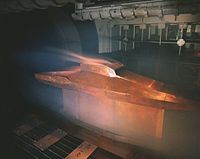Similitude

Similitude is when things are similar to each other. Imagine you have two toy cars, one is big and one is small, but they look exactly the same. Even though they are different sizes, we can say that they have similitude because they look similar to each other.
In science and engineering, similitude is important because we use it to understand things that are too big or too complex to study directly. We make smaller or simpler models that have the same similitude as the bigger thing we want to study. For example, if we want to understand how a plane flies, we might make a small model plane that flies in the same way as a big plane. By studying the small model, we can learn how to make the big plane fly better.
Similitude can also help us compare things that seem very different. For example, we might use similitude to compare how two different animals move. Even though one is a bird and one is a fish, we can study their movements and see that they have similitude because they both use their bodies to move through the air or water.
Overall, similitude is a way to understand the world around us by finding similarities between different things. By understanding similitude, we can make better models, compare different things, and learn more about how things work.
In science and engineering, similitude is important because we use it to understand things that are too big or too complex to study directly. We make smaller or simpler models that have the same similitude as the bigger thing we want to study. For example, if we want to understand how a plane flies, we might make a small model plane that flies in the same way as a big plane. By studying the small model, we can learn how to make the big plane fly better.
Similitude can also help us compare things that seem very different. For example, we might use similitude to compare how two different animals move. Even though one is a bird and one is a fish, we can study their movements and see that they have similitude because they both use their bodies to move through the air or water.
Overall, similitude is a way to understand the world around us by finding similarities between different things. By understanding similitude, we can make better models, compare different things, and learn more about how things work.
Related topics others have asked about:
